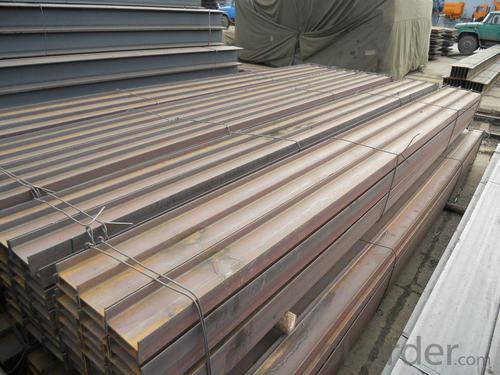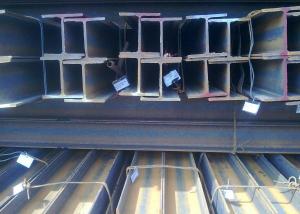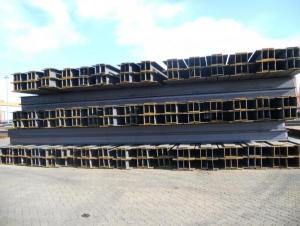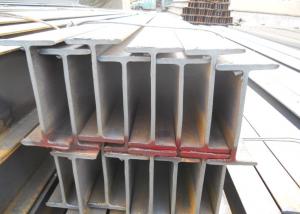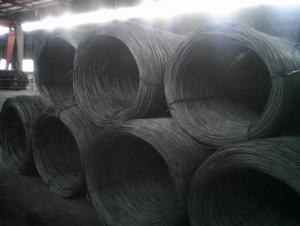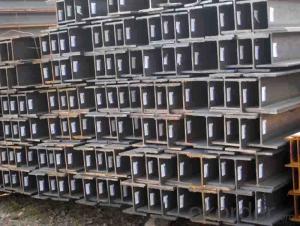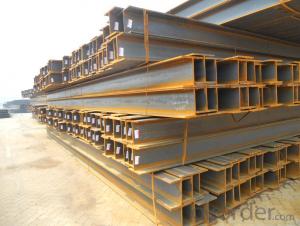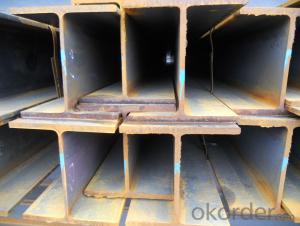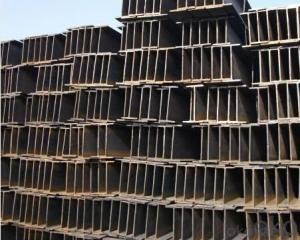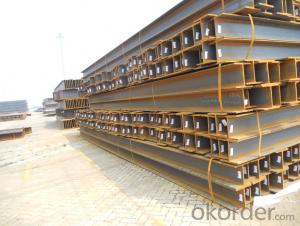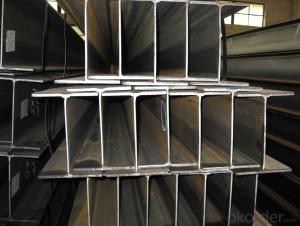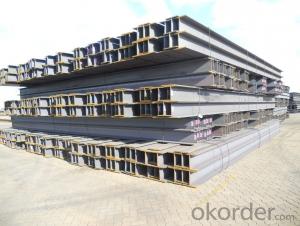Hot Rolled Steel H-Beam for Frame Structure
- Loading Port:
- Tianjin
- Payment Terms:
- TT OR LC
- Min Order Qty:
- 20000 m.t.
- Supply Capability:
- 120000 m.t./month
OKorder Service Pledge
OKorder Financial Service
You Might Also Like
Specification
Product Description:
OKorder is offering Hot Rolled Steel H-Beam for Frame Structure at great prices with worldwide shipping. Our supplier is a world-class manufacturer of steel, with our products utilized the world over. OKorder annually supplies products to European, North American and Asian markets. We provide quotations within 24 hours of receiving inquiries and guarantee competitive prices.
Product Applications:
Hot Rolled Steel H-Beam for are widely used in the construction of buildings and bridges, and the manufacturing, petrochemical, and transportation industries.
Product Advantages:
OKorder's Hot Rolled Steel H-Beam for Frame Structure are durable, strong, and resist corrosion.
Main Product Features:
· Premium quality
· Prompt delivery & seaworthy packing (30 days after receiving deposit)
· Can be recycled and reused
· Mill test certification
· Professional Service
· Competitive pricing
Product Specifications:
Specifications of Hot Rolled Steel H-Beam for Prefabrication structure
1. Standard: Q235B2.
2. Grade: Q235, SS400 or Equivalent
3. Length:10m, 12m as following table
4. Invoicing on theoretical weight or actual weight as customer request
5.Payment: TT or LC
6. Sizes:
SIZE(mm) | DIMENSION(kg/m) |
150*150 | 31.1 |
148*100 | 20.7 |
198*99 | 17.8 |
200*100 | 20.9 |
Usage & Applications of Hot Rolled Steel H-Beam for Frame Structure
Commercial building structure ;Pre-engineered buildings; Machinery support structure; Prefabricated structure; Medium scale bridges; Ship-building structure. etc.
Packaging & Delivery of Hot Rolled Steel H-Beam for Machinery Support Structure
1. Packing: it is nude packed in bundles by steel wire rod
2. Bundle weight: not more than 3 MT for bulk vessel; less than 3 MT for container load
3. Marks:
Color marking: There will be color marking on both end of the bundle for the cargo delivered by bulk vessel. That makes it easily to distinguish at the destination port.
Tag mark: there will be tag mark tied up on the bundles. The information usually including supplier logo and name, product name, made in China, shipping marks and other information request by the customer.
If loading by container the marking is not needed, but we will prepare it as customer request.
4. Transportation: the goods are delivered by truck from mill to loading port, the maximum quantity can be loaded is around 40MTs by each truck. If the order quantity cannot reach the full truck loaded, the transportation cost per ton will be little higher than full load.
5. Delivered by bulk vessel
Production flow of Hot Rolled Steel H-Beam for Prefabrication structure
Material prepare (billet) —heat up—rough rolling—precision rolling—cooling—packing—storage and transportation
FAQ:
Q1: Why buy Materials & Equipment from OKorder.com?
A1: All products offered byOKorder.com are carefully selected from China's most reliable manufacturing enterprises. Through its ISO certifications, OKorder.com adheres to the highest standards and a commitment to supply chain safety and customer satisfaction.
Images:
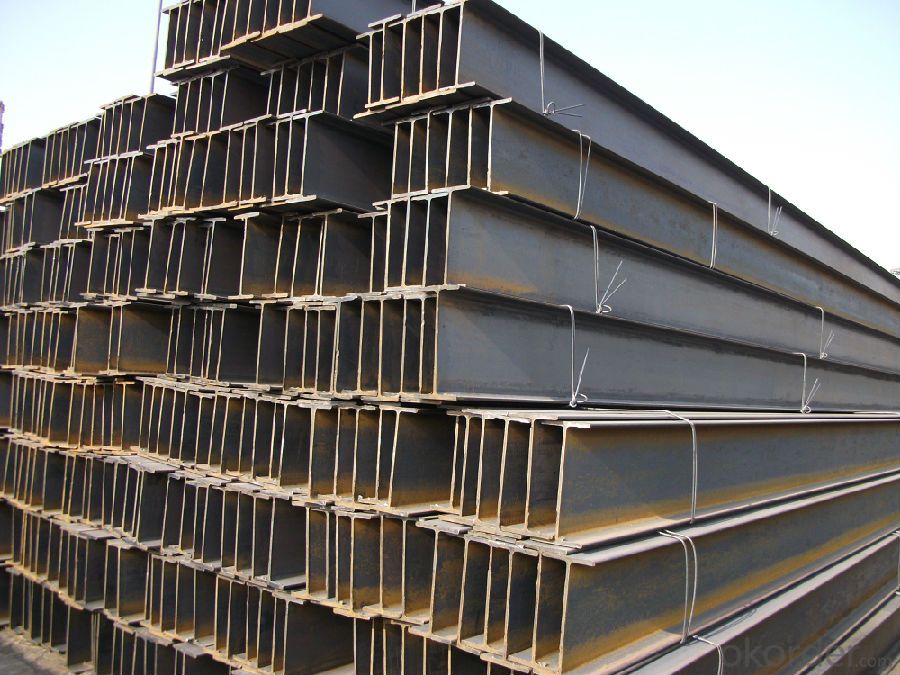
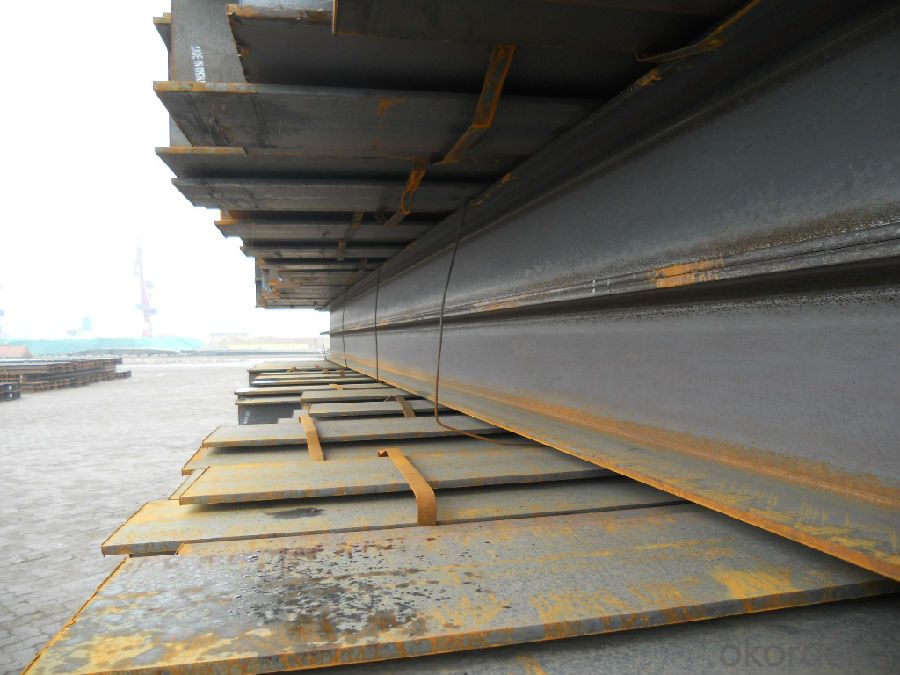
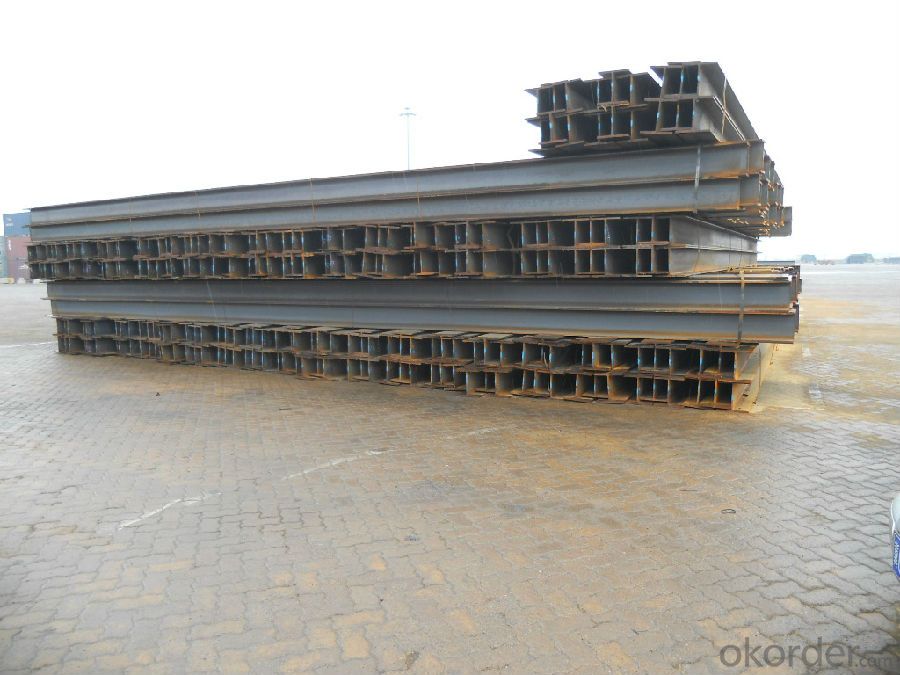
- Q: What are the fire resistance ratings for steel H-beams?
- The fire resistance ratings for steel H-beams depend on various factors such as the dimensions of the beam, the type of fire protection applied, and the specific building codes and regulations in place. Generally, steel H-beams have inherent fire-resistant properties due to their high melting point and structural stability. However, to enhance their fire resistance, additional fireproofing materials such as intumescent coatings or fire-resistant insulations can be applied. These measures can significantly increase the fire resistance ratings of steel H-beams, allowing them to withstand fire exposure for extended periods, typically ranging from 30 minutes to several hours.
- Q: How do you calculate the deflection of steel H-beams?
- To calculate the deflection of steel H-beams, you need to consider various factors such as the dimensions, material properties, and applied loads. The deflection of a beam is typically determined using the Euler-Bernoulli beam theory, which assumes linear elastic behavior and small deflections. Here are the steps to calculate the deflection of steel H-beams: 1. Determine the dimensions of the H-beam, including the height, width, and flange thickness. 2. Obtain the material properties of the steel, such as the Young's modulus (E) and the moment of inertia (I) of the cross-section. These values can be found in engineering handbooks or obtained from the manufacturer. 3. Identify the applied loads on the beam. These can include concentrated loads, distributed loads, or a combination of both. The magnitude and location of the loads are crucial for accurate calculations. 4. Apply the appropriate equations or formulas to calculate the deflection. For a simply supported beam with a concentrated load at the center, you can use the formula: δ = (5 * F * L^4) / (384 * E * I), where δ is the deflection, F is the applied load, L is the span length of the beam, E is the Young's modulus, and I is the moment of inertia. 5. If the beam is subjected to distributed loads, you will need to integrate the load distribution equation along the length of the beam to determine the total deflection. It is important to note that these calculations provide an approximate estimation of the deflection. For more accurate results, finite element analysis (FEA) software or specialized engineering tools may be necessary. Additionally, consulting a structural engineer or referring to relevant design codes and standards is recommended to ensure the safety and structural integrity of the H-beam in real-world applications.
- Q: Are steel H-beams suitable for structures with large spans?
- Yes, steel H-beams are suitable for structures with large spans. H-beams, also known as I-beams or universal beams, are designed to distribute the load evenly along the length of the beam, making them ideal for supporting large spans. The shape of the H-beam provides excellent structural integrity, allowing it to withstand heavy loads and resist bending or twisting. Additionally, steel H-beams have a high strength-to-weight ratio, meaning they can support large spans without being overly heavy. This makes them a popular choice for a wide range of structures, including bridges, buildings, and industrial facilities, where large spans are required.
- Q: Can steel H-beams be used in warehouse or distribution center construction?
- Yes, steel H-beams can be used in warehouse or distribution center construction. Steel H-beams are typically used as structural supports and provide strength and stability to the building structure. They are commonly used in industrial and commercial construction projects due to their durability and load-bearing capabilities.
- Q: What are the different finishes available for Steel H-Beams, such as galvanized or painted?
- There are several different finishes available for Steel H-Beams, including galvanized and painted options. Galvanized finishes involve applying a protective coating of zinc to the surface of the steel beam. This process helps to prevent corrosion and rusting, making the beams more durable and long-lasting. Galvanized H-Beams are commonly used in outdoor or high-moisture environments where corrosion resistance is essential, such as construction projects near the coast or in areas with harsh weather conditions. Painted finishes, on the other hand, involve applying a layer of paint to the surface of the steel beam. This not only provides a decorative aspect but also acts as a protective barrier against rust and corrosion. Painted H-Beams can be custom-colored to match specific aesthetic requirements or to stand out for safety purposes in industrial settings. Additionally, there are other finishes available for Steel H-Beams, such as powder coating. Powder coating involves applying a dry powder onto the steel beam, which is then cured under heat to create a hard, smooth, and durable finish. This finish provides excellent resistance to chipping, scratching, and fading, making it ideal for applications that require a high-quality, long-lasting appearance. The choice of finish for Steel H-Beams depends on the specific application and the environmental factors they will be exposed to. Galvanized finishes are commonly used in outdoor or high-moisture environments, while painted finishes are versatile and can be customized to match aesthetic or safety requirements. Powder coating offers a durable and attractive finish suitable for various applications. It is important to consider the specific needs and requirements of your project when selecting the appropriate finish for Steel H-Beams.
- Q: What are the different types of steel H-beam connections used in airport terminals?
- There are several types of steel H-beam connections commonly used in airport terminals, including bolted connections, welded connections, and moment-resisting connections. Bolted connections involve using bolts and nuts to join the H-beams together, offering ease of installation and disassembly. Welded connections involve permanently joining the H-beams using welding techniques, providing high strength and stability. Moment-resisting connections are designed to withstand bending moments and provide enhanced structural integrity, commonly used in areas with high wind loads or seismic activity. The specific type of connection used in airport terminals depends on factors such as the design requirements, structural loads, and construction techniques employed.
- Q: How do steel H-beams compare to other types of structural beams?
- Steel H-beams are widely regarded as one of the most versatile and popular choices among structural beams. Compared to other types of beams, such as wooden or concrete beams, steel H-beams offer superior strength, durability, and load-bearing capacity. Their unique H-shaped cross-section provides excellent structural integrity, allowing for efficient distribution of weight and resistance to bending or twisting forces. Additionally, steel H-beams can be easily fabricated to accommodate various construction needs, making them a preferred choice in a wide range of applications, including building construction, bridges, and industrial structures.
- Q: What are the differences between hot-rolled and cold-formed steel H-beams?
- The main differences between hot-rolled and cold-formed steel H-beams lie in the manufacturing process and the resulting structural properties. Hot-rolled steel H-beams are formed by heating a steel billet or ingot to a high temperature and then rolling it into the desired shape. This process results in a larger size range and higher load-bearing capacity compared to cold-formed steel H-beams. Cold-formed steel H-beams, on the other hand, are formed by bending or folding a sheet of steel at room temperature. This process allows for greater flexibility in design and a lighter weight, but typically has a lower load-bearing capacity. Overall, the choice between hot-rolled and cold-formed steel H-beams depends on the specific structural requirements and cost considerations of the project.
- Q: How do steel H-beams contribute to the overall cost-effectiveness of a project?
- Steel H-beams contribute to the overall cost-effectiveness of a project in several ways. Firstly, they are an incredibly strong and durable material, which means that they require minimal maintenance and have a long lifespan. This reduces the need for frequent repairs or replacements, resulting in cost savings over time. Additionally, steel H-beams are lightweight compared to other construction materials, such as concrete or timber, making them easier and cheaper to transport and handle on-site. This can lead to reduced labor costs and shorter construction times, ultimately saving money in the overall project budget. Moreover, steel H-beams can be prefabricated off-site, which allows for greater precision and efficiency in the construction process. This reduces the risk of errors and wastage, leading to cost savings in terms of materials and labor. Furthermore, steel is a sustainable and environmentally friendly material. It is 100% recyclable, meaning that at the end of its lifespan, it can be repurposed or recycled, reducing waste and minimizing the environmental impact of the project. This aligns with the growing demand for sustainable construction practices and can potentially result in cost savings through incentives or tax benefits. Overall, the utilization of steel H-beams in a construction project offers numerous cost-effective advantages. Their strength, durability, and low maintenance requirements ensure long-term cost savings, while their lightweight nature and prefabrication capabilities reduce transportation and labor costs. Additionally, the sustainability of steel contributes to potential financial benefits.
- Q: What are the different types of connections used for steel H-beams to concrete?
- There are several types of connections commonly used to attach steel H-beams to concrete. Some of the most commonly used connections include welded connections, bolted connections, and adhesive connections. Welded connections involve welding the steel H-beam directly to embedded steel plates or reinforcing bars within the concrete. Bolted connections utilize bolts and nuts to secure the H-beam to steel plates embedded in the concrete. Adhesive connections involve using high-strength adhesives to bond the steel H-beam to the concrete surface. Each type of connection offers different advantages and may be used depending on factors such as load requirements, construction conditions, and design preferences.
Send your message to us
Hot Rolled Steel H-Beam for Frame Structure
- Loading Port:
- Tianjin
- Payment Terms:
- TT OR LC
- Min Order Qty:
- 20000 m.t.
- Supply Capability:
- 120000 m.t./month
OKorder Service Pledge
OKorder Financial Service
Similar products
Hot products
Hot Searches
Related keywords



